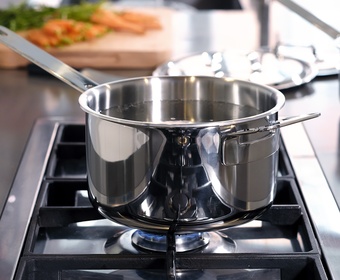About cooking pots/saucepans
Cooking pots receive little attention. But a pot that won't do it's job properly – because it is wobbly, because it doesn’t fit the heat source, because it has poor heating properties, because it has an ill-fitting or clumsy lid, because won’t fit in the oven, because it is unbalanced in your hand, because it has a substandard handle – can make life very difficult in the kitchen.
Thick bottom or bust
The thick bottom of a pot serves two key functions: Absorbing heat and distributing heat. If these requirements aren't fulfilled, it is hard to control the cooking process.
A thin-bottomed pot simply doesn’t work.
– Chef Carina Brydling, Swedish National Culinary Team
Flat contact
The thick bottom also helps maintain the shape of the pot when it gets hot. And the flatter the bottom, the better the contact with a flat source of heat.
Sustainable steel
Stainless steel withstands high temperatures without losing its shape and qualities. It is resilient and does not end up being thrown away as fast as a pot with a non-stick layer, for example.
Perfect for food
Stainless steel is not damaged by water, fat, acidity, salt, or bitter ingredients. It won't release any substances that might end up in your food. Enamel pots are also "food neutral", but not quite as tough as steel.
For all materials
Steel, plastic and wooden kitchen tools. All go well with a stainless steel pot.
On temperatures
- 0°C – Water freezes
- 5°C – Pathogens start/stop reproducing
- 57°C – Most pathogens die
- 78°C – Alcohol (ethanol) boils and evaporates
- 80°C – Optimal temperature for many teas
- 100°C – Water boils (and milk too)
- 140 – 165°C – The Maillard effect (food is seared/toasted)
- 160 – 180°C – Suitable temperature for deep frying
The art of boiling
- A large amount of water means smaller fluctuation in temperature when you immerse the food. Protein foam on the surface is a telltale sign of insufficient heat.
- Use a lid to save time as well as energy.
- Ingredients like wine, vinegar, lemon and tomato all contain natural acids. Boil them in enamelled or stainless steel pots.
- Add fresh herbs late when boiling, or essential oils (flavors) will evaporate.
- Fish should never boil, only simmer.
Pour correctly
Copy the pros, hold your pot and organize your workplace so that you always pour the contents away from yourself. Follow the same precaution when adding food to hot water.
Allow for margins
An oversized pot is better than an undersized one. An experienced chef does not try to boil two liters of rice in a pot that holds two liters.
A lid preserves
Pathogens thrive between 5 and 57°C. Food that has been boiled is practically free from contaminants. For optimal hygiene, keep the lid on after boiling.
Oven proof
A good pot can go in the oven too. A steel lid and steel handles will do the job – but beware, they will get hot.
Precious kitchen space
In a professional kitchen, cooking pots are constantly used and for many purposes. This puts demands on storage space. Stackable pots make a lot of sense.
Clean and dry
Even stainless steel and enamel pots can develop stains if subjected to water or acidic ingredients for long periods of time. A clean and dry pot is more attractive, and will also last longer.
Cooking pot/saucepan care
Dishwasher detergents might contain abrasive substances that will give the steel a dull appearance if machine-washed frequently, but the pots qualities will not be affected.
Clean with hot water and washing-up liquid and dry with a kitchen towel.
Fill with water and leave for a few hours to loosen up and remove burnt food.



